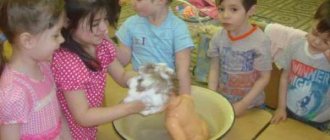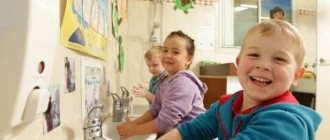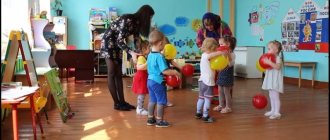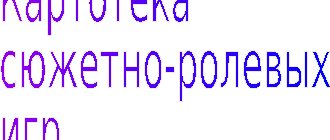Long-term plan for developing cultural and hygienic skills in the middle group
Transcript
1 Long-term plan for the education of cultural and hygienic skills in the middle group Educators: Tsidik E.A., Kovaleva N.F. Regime processes Contents of skills Methodological techniques September hold the fork with your thumb and middle fingers, holding it on top with your index finger. Conversation “Let's remember how to eat properly”; Russian folk tale "Zhikharka". Straightening the bed, dressing and undressing independently in a certain sequence, carefully folding and hanging clothes on a chair before going to bed. washing: soap your hands until foam forms, rinse thoroughly, wipe dry with a towel. Learn to dry and clean your clothes and shoes, strengthen the ability to straighten your bed October Learn to eat different types of food without changing the position of the fork in your hand, but only slightly turning your hand. correctly place your things in the closet, strengthen the ability to tie shoelaces, fasten sandals. wash your face, wipe dry with an individual towel. Straighten the bed: fold the bedspread neatly, straighten the blanket. Poem "Masharasteryasha" "Who puts the clothes correctly and quickly." Reading: I. Ishchuk “My palms” “How to straighten the bed.” Russian folk tale “The Three Bears” Reading by N. Litvinov “The Kingdom of Cutlery”. Conversation “Every thing has its place.” Reading an excerpt from the poem “He’s so absent-minded” “Let’s tell the kids how to wash themselves.” Children reading nursery rhymes by heart: “Water, water...” Reading by S. Mikhalkov “I myself.”
2 Straightening the bed Dressing and undressing November using a fork. dress and undress in a certain sequence, use different types of fasteners. Wash yourself properly and use a handkerchief in a timely manner. making the bed, the ability to carefully cover the bed with a blanket. December eats the second course, holding the knife in his right hand and the fork in his left hand. neatly fold and hang clothes on a chair, dress in a certain sequence. proper washing, using an individual towel. dry and clean your clothes, wipe your shoes “We’ll tell the kids how to use a fork correctly” Reading I. Bursov “Galoshes”, S. Mikhalkov “I Myself”. Exercise “Who will put the clothes correctly and quickly.” Reading K. Chukovsky “Moidodyr” (excerpts). “Who will make the bed correctly and quickly.” Conversation “How to properly eat a second course.” Exercise “How we can put things in order.” Uspensky “Destruction” Reading A. Barto, P. Barto “The Dirty Girl”. Conversation “How to take care of your clothes.” January there is a second course. use a napkin to read Dragunsky’s story “The Secret Becomes Revealed”
3 necessities. Teach children to independently maintain cleanliness and order in their closet. wash quickly and correctly. wash, wipe, clean your shoes. Learn to sew on torn buttons. Take part in changing bed linen. February: Use a knife and fork at dinner, and a napkin as needed. To independently maintain cleanliness and order in your closet, wipe yourself dry only with your own towel, taking it from the cabinet and unfolding it on your palms. dry and clean your clothes, wash, wipe, clean your shoes. put a clean pillowcase on the pillow and spread a sheet. Conversation “How we put things in order in our wardrobe” Game-dramatization based on the work of A. Barto, P. Barto “The Dirty Girl”. Reading by D. Krupskaya “Cleanliness” Reading the English folk song “Robin Bobin Barabek” Game competition “Let’s put things in order in the lockers.” Reading an excerpt from K.I. Chukovsky’s fairy tale “Moidodyr” “Long live fragrant soap.” “Let’s help the junior teacher change the bed linen.” March: Use cutlery correctly; eat the second course with a knife and fork. Conversation “Why the second course is not eaten with a spoon.” Reading Russian nursery rhymes: “Little bunny is a coward”, “Grandfather wanted to cook his ear”, turn the clothes taken off Reading M. Zoshchenko “Stupid Story” on the front side, carefully put on the shoes Conversation “Our microbes”
4 making the bed making the bed wash quickly and carefully, be sure to wash your hands with soap after visiting the toilet. Form the habit of taking care of your appearance. take part in changing bed linen. April eat the second course with a knife and fork, without moving them from hand to hand, eat with your mouth closed. fold clothes carefully before going to bed, turn sleeves inside out, straighten clothes. Reinforce the rules for washing and maintaining order in the washroom. Continue to form the habit of monitoring your appearance, remind your comrades about problems in their appearance. Learn to take part in changing bed linen: put on a clean pillowcase, and with the help of an adult, put the duvet cover on the blanket. enemies" Conversation "Cleanliness is the key to health" Conversation "Food culture is a serious matter", B. Zakhodera "Pussy Woe" Game-competition "Whose chair is the neatest", repetition of nursery rhymes on the topic Reading E. Vinokurov "Bathing children" "How to help a friend" . May children eat with their mouths closed and chew food silently. children to maintain order in their wardrobes, strengthen the ability to use different types of fasteners on shoes and N. Gernet and D. Harms “Very, very tasty pie” “Who has order in the closet”
5 tucking tucking clothes, tying shoelaces. wash your hands with soap after visiting the toilet and as needed. Form the habit of reminding your friends about problems in their appearance, show a desire to help them, and improve the ability to sew up clothes that are torn at the seams. change the bed: lay out a clean sheet, put on a pillowcase and duvet cover. June Use cutlery correctly when eating, keep the cutlery above the plate. Children help their friends get dressed: fasten a button, straighten a collar. Strengthen and improve the habit of keeping your body clean. Constantly monitor your appearance and troubleshoot problems. Conversation “Clean hands, healthy children” Reading an excerpt from V. Mayakovsky’s work “What is good and what is bad” Productive activity: sewing doll linen. Reading Permyak’s story “How Masha became big” Role-playing game “Kindergarten” Reading “Jam” by O. Grigoriev. Reading S. Mikhalkov “Everything by myself.” Reading T. Kozhomberdiev “It’s all the same.” “Who is the neatest” by E. Uspensky “If I were a girl” July, while eating, keep the cutlery above the plate, at the end of the meal, put it on the edge of the plate, and not on the table. neatly hang things in the closet and fold them on a chair. Role-playing game "Cafe". I. Tokmakova “Plim” (2 quatrains) Reading by Y. Akim “Neumeika”.
6 refueling refueling Consolidate and improve acquired skills, cultivate the habit of keeping your body clean. Learn to sew on loose loops. Make the bed completely after sleep. August To consolidate and improve the skills of eating culturally, using cutlery and napkins correctly. quickly dress and undress, maintain order in the closet, help comrades. wash your hands with soap after visiting the toilet and as needed. Constantly monitor your appearance, help your comrades troubleshoot problems with their appearance, and take part in changing bed linen. “Whose towel is clean has washed himself correctly.” Showing, reminding, indicating, recalling and naming familiar works on the topic. Role-playing games: “We are at a birthday party”, “Cafe”. Game competition “Who is the fastest”, “Who is the neatest”. Reminder, reading an excerpt from K. Chukovsky’s poem “Moidodyr” Productive activity: repairing doll clothes.
Formation of cultural and hygienic skills in preschool children
(From work experience)
Formation of cultural and hygienic skills in the middle group, the task was to consolidate previously acquired knowledge with children and acquire new cultural and hygienic skills.
At this age, children are already quite independent, but strengthening cultural and hygienic skills is necessary.
Every day in kindergarten begins with the reception of children by the teacher. What is necessary for successful hygienic education is unity of requirements on the part of adults.
The educator has a big task to help parents correctly instill in their children cultural and hygienic skills. To do this, I systematically carried out sanitary and educational work among parents. She explained the importance of following the daily routine established in the children's institution. The work was carried out in the form of conversations and during the reception of children. I conducted a survey to find out: “Does the child have his own room, does he have toys, where are they stored in the house, how does the child help in the house, what do the parents say to the child for the help provided.”
I constantly asked parents whether they forgot to provide their child with a handkerchief, in the summer - a towel for his feet, spare underpants, T-shirts, socks, tights, and a personal comb.
She conducted individual conversations, observations, entertainment, and games with the children. Individual conversations - the main goal of these conversations is to consolidate children’s knowledge of how to properly wash their hands, care for their hair and things, to consolidate the ability to use soap, a comb not only for girls, but also for boys, and a handkerchief.
Together with the children, we watched the work of the assistant teacher, how she straightened and tidied up the bed, in what order, and taught the children this too. Together with the children, they looked at the results of their work and assessed how the children’s bedroom would look cozy.
We observed how the people around us were dressed. The main purpose of observations is to help children see how to perform actions correctly, to teach them to see problems, sloppiness, and to direct children’s actions in the right direction.
Manuals were used to reinforce these skills. These manuals helped children learn how to lace their shoes correctly, and subsequently do it independently and carefully.
The training took place in a playful way; through play, cultural and hygienic skills are learned better and faster. Children were offered role-playing games.
In the role-playing game “Barbershop,” children consolidated their skills in communicating with each other, combing, and tying bows.
In the “Family” and “Kindergarten” games, children consolidated behavioral skills, routine moments: sleep, washing, lunch, activities, how to set the table, how to behave properly at the table, neatly fold things, etc.
Didactic games were organized, the games reinforced children's knowledge about items to use in the bathroom: find items for brushing teeth, washing hands, face with soap, combing hair.
The children were told that it is very important to be a clean, neat, neat, combed, polite person.
Together with the children, we cleaned the dolls' corners and washed the dolls' clothes. After all, it is very important for children to be in beautifully decorated rooms.
Beautiful soap dishes were placed in the washroom, beautiful towels with children's drawings were used, and corresponding visual images were used in the washroom.
The children really enjoyed washing their hands and taking soap from beautiful soap dishes and drying their hands with beautiful towels.
In order for children to instill cultural and hygienic skills, it is necessary to create all possible conditions for this, to increase the interest of children through works of art, role-playing games, didactic, visual aids, and of course, to apply the skill correctly and consciously in various forms available to children to instill cultural and hygienic skills.
Conclusion
In the course of such a big work on teaching cultural and hygienic skills in the senior group, the children mastered the skills of personal hygiene and culture of behavior.
Efficiency of work is achieved through a rational selection of methods and techniques. This was mainly achieved using visual methods, as this attracted the attention of children more.
In my work I achieved a certain goal that was set for working with children. There were also failures in personal hygiene and communication culture; we had to help. In the work carried out with children, the necessary materials and manuals were used.





